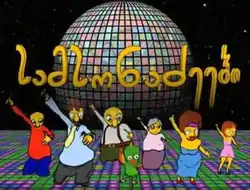The Samsonadzes
The Samsonadzes (Georgian: სამსონაძეები, Samsonadzeebi) is a Georgian CGI animated television sitcom created and produced by Shalva Ramishvili. It first aired in Georgia in November 2009.[2] It almost immediately became a "hit", "taking Georgia by storm" and "shooting to the number two spot among the most-popular shows on one of Georgia's main TV channels". It has been described as "bearing more than a passing resemblance" to the American animated television sitcom The Simpsons.[2]
| The Samsonadzes | |
|---|---|
 | |
| Genre | Animation Comedy |
| Created by | Shalva Ramishvili |
| Country of origin | Georgia (2010), America (2021) |
| Original languages | Georgian, English |
| No. of episodes | 18[1] |
| Release | |
| Original network | Imedi TV |
| Original release | November 2009 – 2010 |
The Samsonadzes are "a yellow-skinned cartoon family, consisting of a dopey husband" (Gela Samsonadze, who works in a bank) "and his lavishly coiffed wife, who live in a made-up city with their children", Shorena and Gia. They also have a parrot, Koke.[2] Their home city has been noted for its apparent resemblance to Tbilisi.[1]
Ramishvili has stated that the series aimed to be "relevant to Georgian reality and touch on social issues that will resonate with a Georgian audience",[2] while its chief scriptwriter, Zviad Bliadze, explained: "We just took an average family and made a parody of the common traits, like laziness or love of alcohol."
The series has attracted some attention by featuring Russian leaders in a negative light, in a context of tense Georgia–Russia relations. Russian Prime Minister Vladimir Putin appears in one episode, sending a spy into Georgia.[2] Ramishvili described this criticism of the Russian government as "simply our civil liberty and duty".[3] The Independent, however, has remarked that there are "no plans to introduce the controversial Georgian President, Mikheil Saakashvili" into the programme, and Russia Today has noted that the series' creators "make lots of fun of Russian politicians, while forgetting their own."
References
- "Putin appears in Georgia's Simpsons-like cartoon show", British Broadcasting Corporation, February 3, 2010
- "Georgia's answer to 'The Simpsons'", The Independent, December 18, 2009
- "Georgia's answer to the Simpsons", The Guardian, January 15, 2010